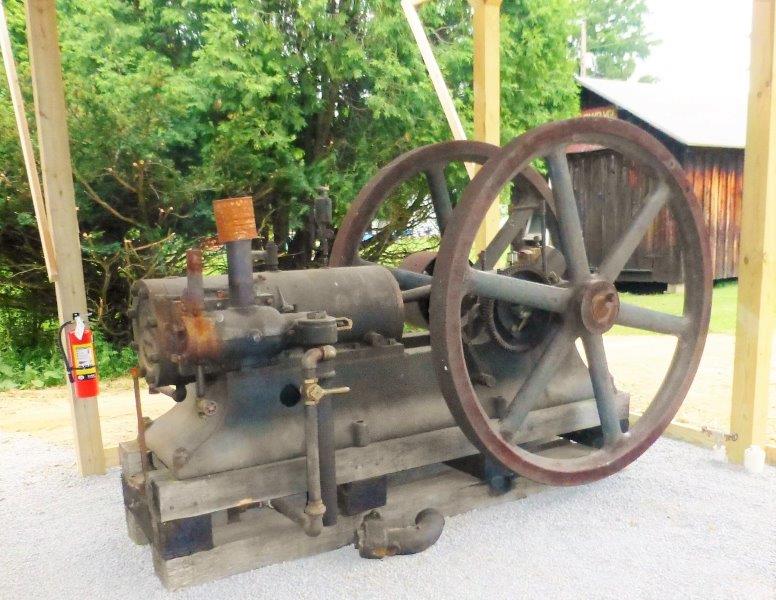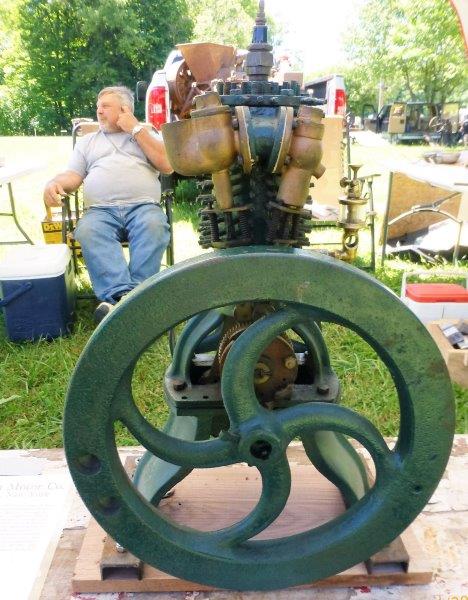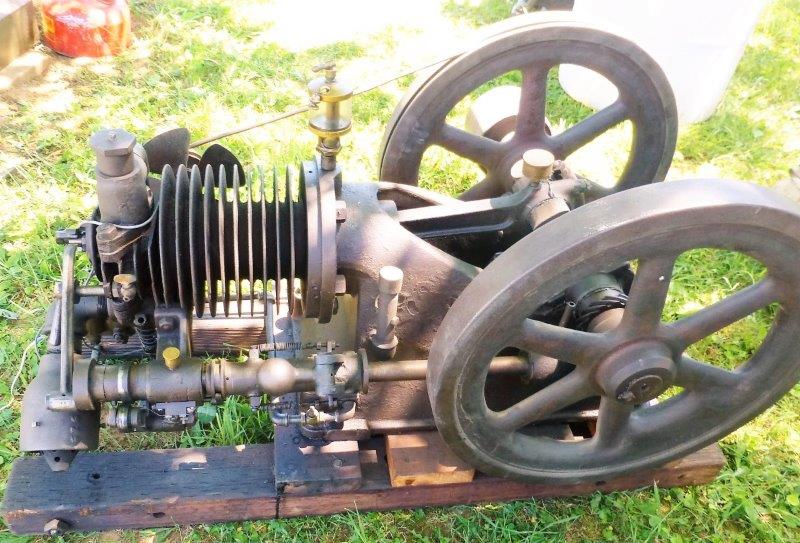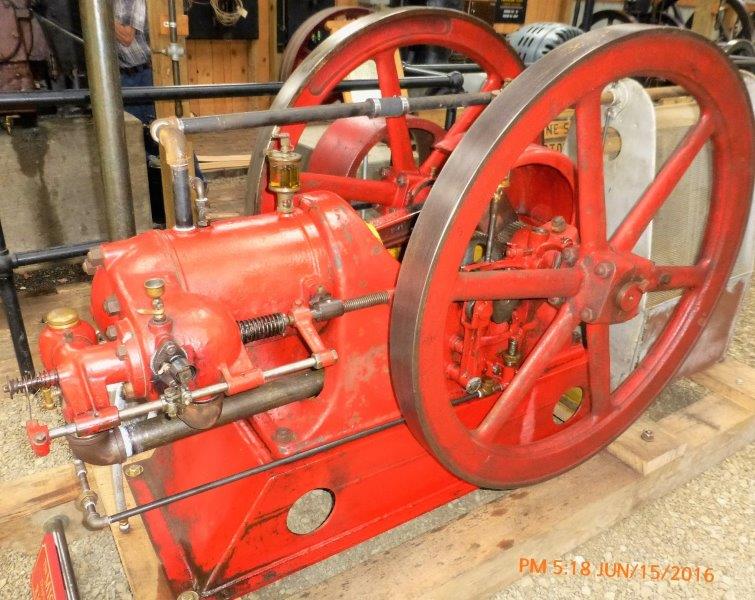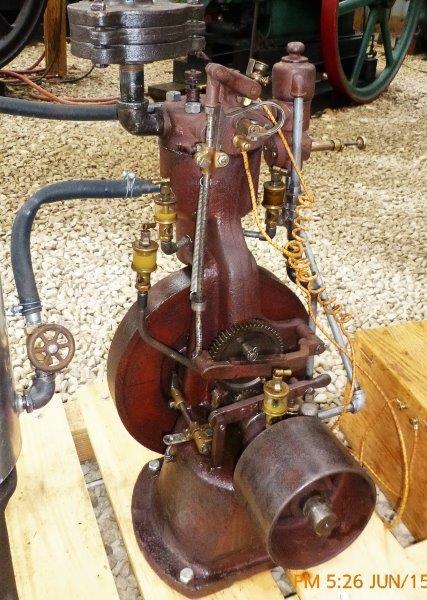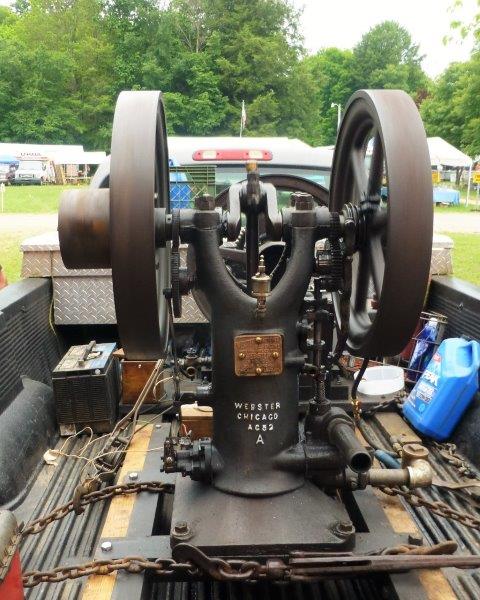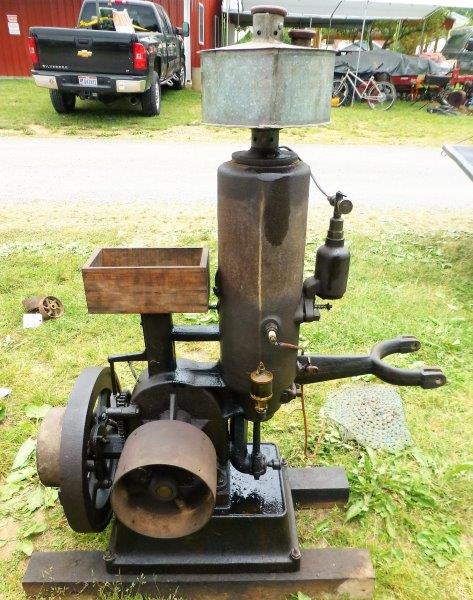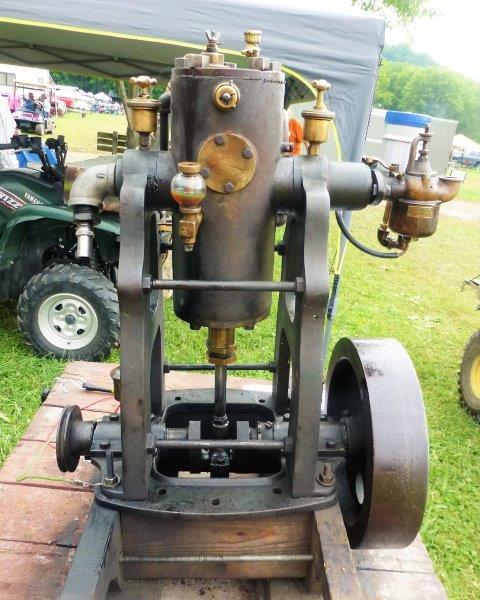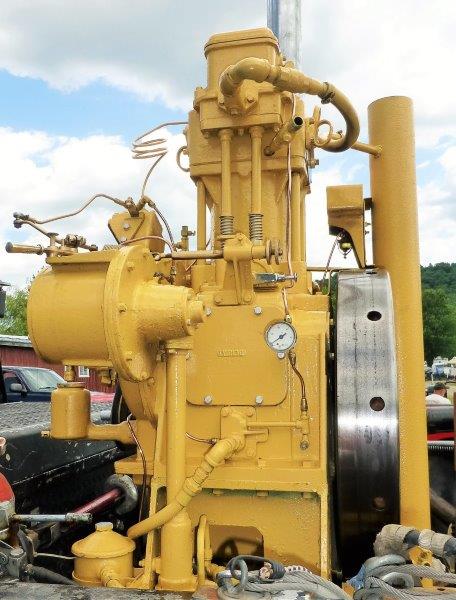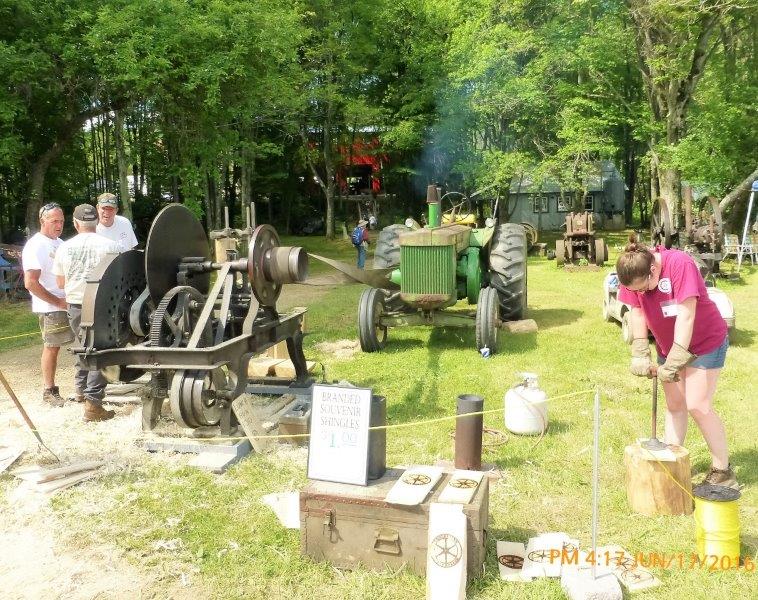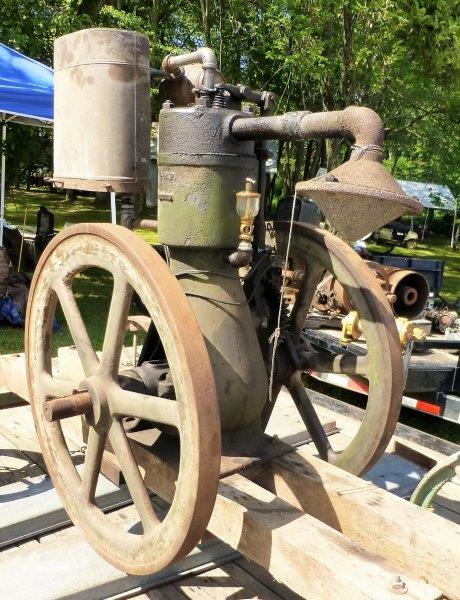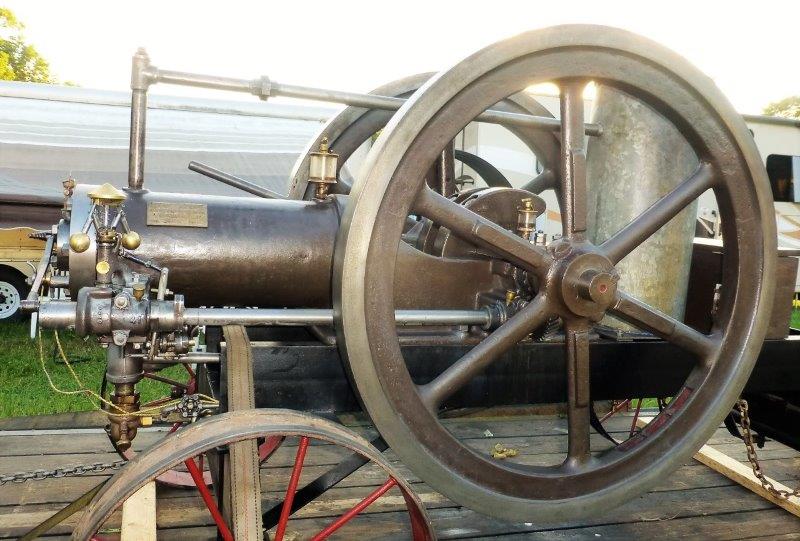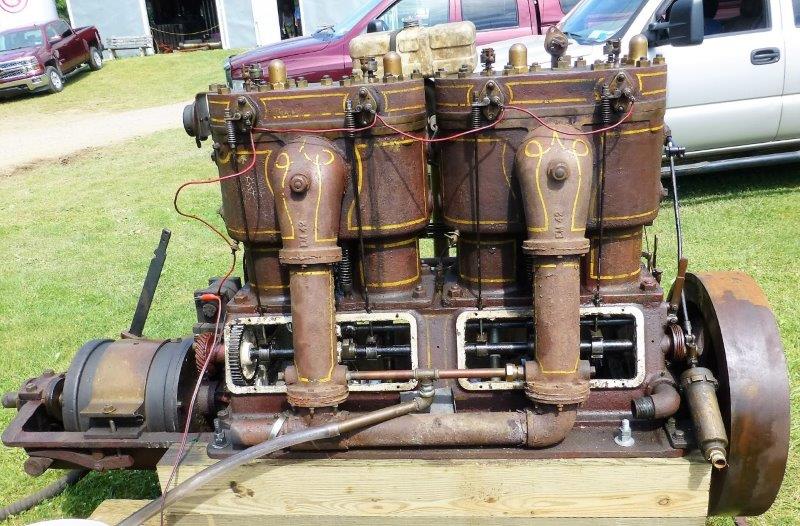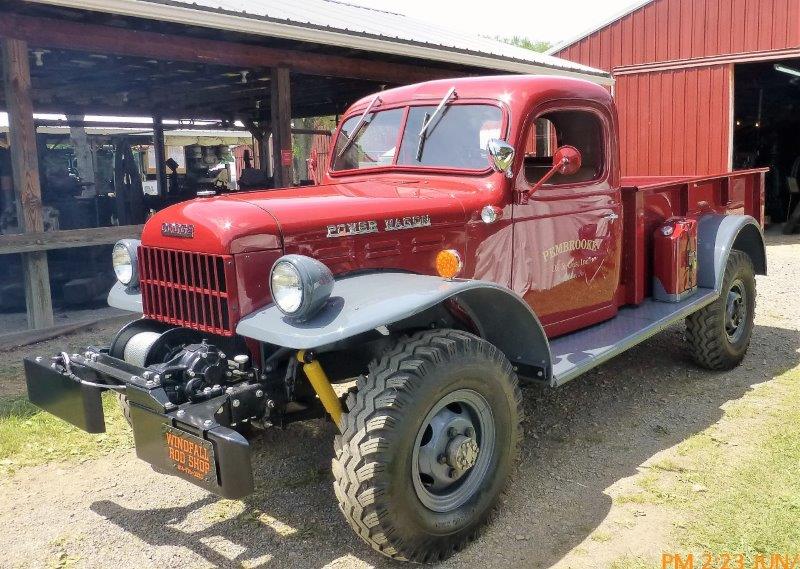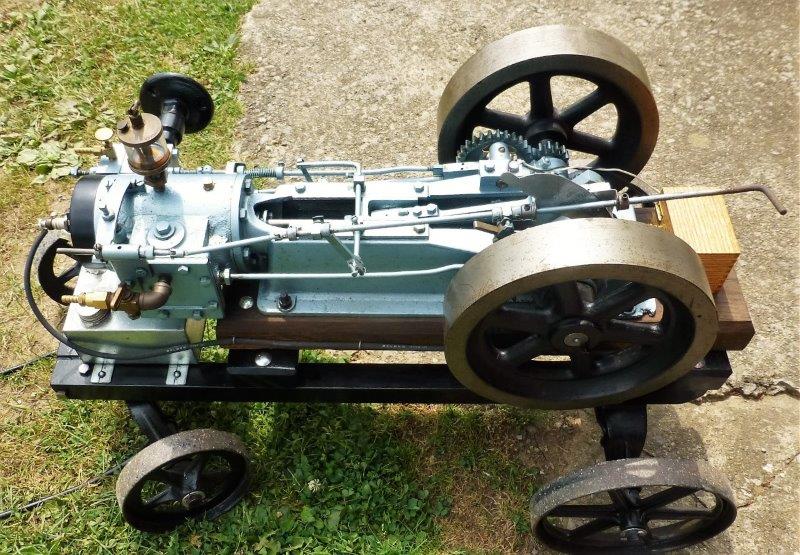|
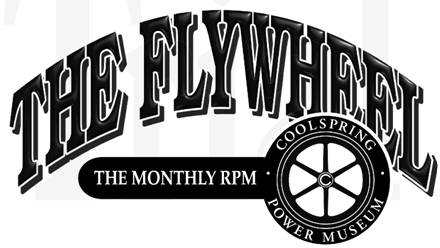
August 2016
June Show Report
By Paul Harvey
The June 2016 Engine Show was perfect! The weather was great and,
despite a shower after dark, we did not have the usual mud and dismal
skies. Everyone seemed relaxed and happy to enjoy the engines they
exhibited in the show areas and also happy to enjoy all the museum's
engines. There was plenty of good food and a great flea market. I hope
such a great experience can happen again.
Our theme this year was "One-of-a-Kind Engines," and so many were
exhibited here. I certainly learned a lot by seeing machines that I had
never been aware of before. The engines exhibited in the show field
represented many unusual and unique designs. It was a joy to tour.
Proceeding with the photo tour of the show, Photo 1 shows
Steve Tachoir's 30 hp Olin placed in the new engine pavilion. This was
the first engine installed there. It is a beautiful, old style Olin and
now runs. It had been a static display on the front side of the John P.
Wilcox Power House for about 40 years. The original location was a
South Penn oil lease near Warren,
Pennsylvania. Reportedly, it last ran in 1967.
Photo 2 shows Chris Austin's 20 hp Bradford Improved
engine still waiting to be unloaded and operated. Built by the
Combination Engine and Compressor company of
Bradford, Pennsylvania, it
is the only one existing. It is a four-cycle engine with an enclosed
crankcase and pendulum governor. Most unique, it is a straight engine,
without the compressor cylinder, and operated a rod line pumping power
just north of Bradford, PA.
A little vertical engine, built by the American Motor Company
of New York City, is seen in
Photo 3. Manufactured in the 1890s, it features a unique
"V" arrangement of the valves. Rated at one horsepower, it weighs a
mere 50 pounds. Air cooling was accomplished with wire wrapped around
the pegs on the cylinder. It is based on the 1889 patent of Lyman
McNeth, number
407,961.
Don Worley always brings a pleasant surprise and this air
cooled, old style Jacobson was no exception. Note Photo 4.
Its precision cylinder fins for air cooling are actually cast and
not machined. It has the side shaft governor and electric igniter.
Homemade "one-of-a-kinds" are always interesting, as Vince
Barber proves with his engine. Shown in Photo 5, it
features a very long and graceful connecting rod, and is a joy to watch
run. Looking closely, I can see pipe fittings and other items found
around his shop. Creativity was certainly the beginning of the gas
engine.
Photo 6 is a massively built engine identified
as The Michigan. Displayed by Bob and Steve Upham, it has graceful
curved lines on the head and valve chest. It runs, nicely of course,
hit and miss with an electric igniter. A placard denotes that it is
shown in memory of Richard Doty.
Most of us are familiar with the Bates and
Edmonds line of engines, made in
Lansing, Michigan. But
this one, Photo 7, owned by Woody Sins, is most
unusual. It has an overhung power cylinder and flywheel crank shaft.
Many familiar features are seen on close inspection. It actually makes
sense, being a compact design for small power applications. Most all
parts are easily accessed for repair and adjustment.
Stiles Bradley brought his diminutive 1½ horsepower,
inverted Webster, as seen in Photo 8. It features two
sets of timing gears, one to operate the exhaust valve, and the other to
power the igniter. It ran great and attracted a lot of attention.
Photo 9 is a squat little engine that has to be
described as "cute." It is four-cycle and made as a stationary engine,
but has the appearance suggesting marine usage. It was built by Gleason
& Bailey & Sciple of Seneca Falls,
New York. Yes, the name plate has an "&"
between each name! Note that the head, cylinder, and base are all one
casting. A machinist's nightmare!
Charles Stickney built many unusual engines and Photo
10 is no exception. This little engine was built to power a
water pump; notice the forked rod that lifted the well plunger up and
down. It features an overhung cylinder and all the complicated valve
motion that was typical of Stickney. Note the gasoline tank is mounted
on the very top of the engine.
This amazing tractor, Photo 11,
was displayed by Nick Rowland and his dad, Ed. Built by the
Sexauer Brothers of Sulfur Springs, Ohio, it shows both extremely crude,
as well as very sophisticated, design. Circa 1904, its main use was to
buzz saw wood. It could easily drive to the location of the saw, do its
work, and then drive back home again. Fortunately, they found it
preserved in a corn crib where it had rested for many years. The engine
is Sexauer's own design and features desmodromic valve motion; meaning
that the valves are both opened and closed under power. Ignition is by
a Goodson magneto and plug, and it operates beautifully.
Photo 12 is an engine with an oscillating
cylinder to permit the intake and exhaust functions. Displayed by Dave
Deardorff, it is absolutely fascinating to watch run, with the cylinder
oscillating back and forth in its mountings. This design was used in
steam engines, but never before have I seen it in gas engines. It was
made by Henry Philomen LaTour of Copper Cliff,
Ontario, Canada,
for marine use.
The Lutz opposed piston engine is shown in Photo 13.
It was built by Thomas J. Lutz of Mansfield,
Ohio, as a model to obtain his 1906 patent. It
appears crude at first glance, but it is very intricate and operates
beautifully. He did obtain the patent but never produced any of the
engines for sale. This one powered his small machine shop faithfully
for many years.
Photo 14 depicts a single-cylinder Caterpillar
test engine built in 1938. It is displayed by Gene Shepherd of
Shelter Island, New York.
The engine is single-cylinder with a 5¾ inch bore and 8 inch
stroke producing 25 hp at 900 RPM. Major companies commonly built test
engines to try their new designs, but they were usually scrapped after
the testing to prevent the competition from using them. It is great
that one has survived and lives again.
Although not a "one-of-a-kind," a shingle mill always is
popular with our guests. Photo 15 shows Phil St. Jean
chatting with a couple of visitors while standing behind his 1912 Chase
Shingle Mill. Built in Orange,
Massachusetts, these amazing machines cut
tapered wooden shingles from pieces of logs. Phil made several hundred
shingles during the show. To the right is 15-year-old Denali John who
is branding each shingle with the Coolspring Power Museum logo. The
branding iron must be reheated in the propane furnace for each shingle!
The mill is powered by my 1952 John Deere "R" diesel tractor. Branded
and milled shingles were available to the visitors for a $1.00 donation.
Photo 16 shows a nice little 4 hp engine that
was labeled as "unknown." I had no idea of its identity, either. It is
a vertical with a rounded but open crankcase and hit and miss governor.
Since then, it has been identified as a Witte vertical made for them by
the Star Mfg. Company. I am still looking for more information.
"The Earl" is a very pleasantly proportioned side shaft
engine with a vertical governor. It is shown in Photo 17.
It was built by the Earl Machine Works of
Burlington, New Jersey.
Noted as 6 hp, it is serial number 37. I wonder how many were built?
An unusual four-cylinder marine engine is seen in Photo
18. Displayed by Dieter Lund, it was built by the Standard
Motor Construction Company of Jersey City,
New Jersey. It has a unique valve motion, as
well as electric igniters. Note the reversing clutch on the left side.
Standards are very rare, and this is the first large one that I have
seen.
This beautifully restored Dodge Power Wagon brings back
memories of the trucks used in the former days of the oil field. See
Photo 19. Indeed, this one is owned by Ray and Linda
Stiglitz of the Pembrooke Oil and Gas company. It look like it is ready
to work in all the mud and grease!
Finally, Photo 20 shows a little engine
displayed by Ron McClellan. It is designed to operate as a steam engine
or a gas engine. Initially thinking that it was built by Riddle Machine
of Claintonville, Pennsylvania, I have since found a patent that it is a
Victor Palm from Butler,
Pennsylvania. It now resides in Coolspring and
it will be interesting to further investigate its history and operation.
I hope the reader will enjoy this tour of Coolspring's 2016
June Show and a few of the great engines displayed. There were so
many more.
Next month, we will tour back memory lane to view some
of the late Dr. John Wilcox's early photos. Recently converted to
digital format, they will bring back many memories.
|

